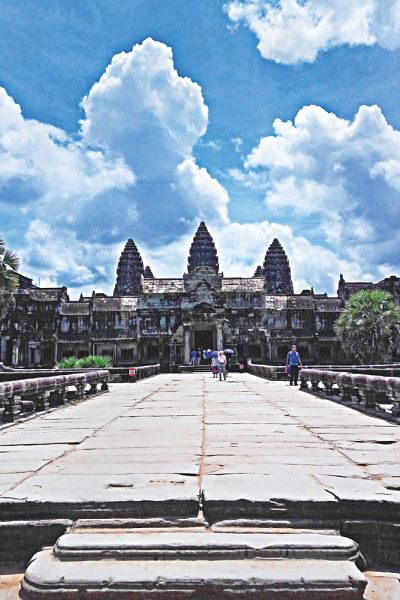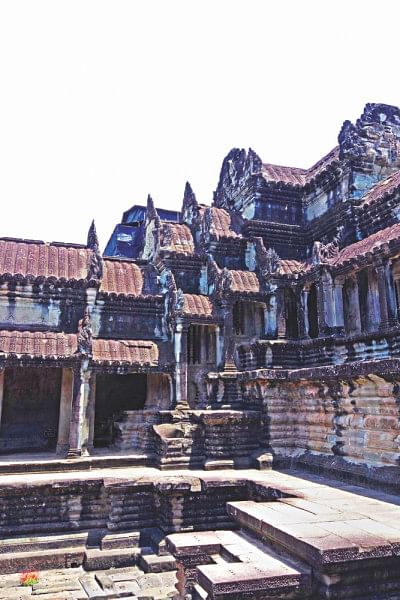Siem Reap—The city of stones


When it comes to Southeast Asia, tourist destinations popular among Bangladeshis are: Thailand, Malaysia, Singapore, and after the initiation of visa on arrival, Indonesia (Bali, more or less). Vietnam is becoming somewhat popular in recent years. Cambodia and Laos, however, still don't see a sizeable number of Bangladeshi travellers. Surprising, because the former boasts Angkor Wat, the largest religious monument in the world, attracting over two million foreign tourists per year.
This year I decided to tick Angkor Wat off my bucket list and in Cambodia I didn't go beyond Siem Reap, the resort town that houses the Angkor temples. If I had to describe the city in a few words, I'd call it 'City of Stones'. Angkor Wat, Angkor Thom, Ta Prohm are globally renowned tourist attractions but there are too many temples [and beautiful ruins] to list in this write-up—all made of stone. But before we can get to that, let's go over how to get to Cambodia.
Visa and how to get there
Holders of passports issued by most countries can purchase visa on arrival at the port of entry in Cambodia. Holders of passports issued by Afghanistan, Algeria, Bangladesh, Iran, Iraq, Pakistan, Saudi Arabia, Sri Lanka, Sudan, and Nigeria are required to apply for entry visa into Cambodia only at a Cambodian embassy or consulate [because we're SPECIAL]. Since there's no Cambodian embassy or consulate in Bangladesh, you can either apply for the visa in New Delhi, India or Bangkok, Thailand. I chose to fly to Siem Reap via Bangkok, so I applied for the visa there.

Before you can apply for a Cambodian visa, you'll need a Thai re-entry permit on your single entry tourist visa [if you're a holder of a passport issued by one of the SPECIAL countries, the Cambodian immigration will want to make sure that you're definitely, positively, certainly returning]. It's a fairly straightforward procedure, for which you'll need to go to Bangkok Immigration Office at Chaeng Wattana. They'll stamp your passport and give it back the same day; just try to turn everything in before lunch hour. Once you get the re-entry permit, go to the Cambodian embassy in Bangkok and apply for a tourist visa—a simple affair that shouldn't take over a couple of hours.
Despite having everything in order, I was still questioned by the immigration police at Siem Reap International Airport. They wanted to be sure that I was a harmless tourist and intended to go back to Bangkok from Siem Reap. Oh well.
Once you're done with all the less than pleasant experiences that we, green passport holders, take for granted, you're in for a good time. Cambodia is, for the most part, inexpensive. Most places in Siem Reap accept USD and give change back in USD. #Win. You can also use your credit card. Best part: you can eat all the steamed rice rolls [packed with fresh herbs and seafood] you want.

A buffet of attractions
As mentioned earlier, there are plenty of tourist attractions in Siem Reap. Depending on your time there, make a list of the ones you want to see. Some hotels offer sensible package tours. You can also take tuk tuks [quite cheap] and temple hop according to your own pace. Something about Cambodian tuk tuks that needs to be mentioned: I've never seen a motorbike-drawn carriage before. You'll need to purchase an Angkor-pass that allows entrance to all of the main temples and related sites. You can get passes that are valid for 1 day [USD 37], 3 days [USD 62] and 7 Days [USD 72].
You could start with Angkor Wat, really early in the day [watching the sun rise kind of early]. I say you "could", because it's a choice. Angkor Wat during sunrise is the Cambodian equivalent to Ramna Park during sunrise on Pahela Baishakh. Also, I'm not an early bird. Surrounded by a moat, Angkor Wat covers over 400 acres. Needless to say, there's a lot of walking and climbing involved; you kind of have to be physically fit. Then again, I've seen sprightly Chinese and Japanese grandmothers sauntering around like they are on their morning walk. If you go during the "wet hot months" [April-November], like I did, you might not enjoy the heat or torrential rain but you will enjoy not overcrowded tourist attractions.
I'm going to refrain from providing detailed descriptions of the attractions, because I strongly believe in seeing it for yourself. But if you ask me if I found Angkor Wat overwhelming, the answer would be, not really. I suppose I would've been overwhelmed had I not already been to Borobudur and Prambanan temples in Yogyakarta, Indonesia. Don't get me wrong, Angkor Wat is awesome nevertheless, and you should totally see it.
From Angkor Wat I went to Ta Prohm aka the "Tomb Raider temple". Yes, an archaeological site made famous by a Hollywood blockbuster, or more specifically, Angelina Jolie; tour guides will make sure you memorise this piece of information. What sets Ta Prohm apart, are the giant trees growing out of the temple and surrounding ruins.
The other major attraction in Siem Reap is Angkor Thom, the enduring capital city of the Khmer empire. The main gate into Angkor Thom alone is spectacular. At its centre is what I consider to be the jewel in its crown, Bayon Temple, with the many smiling faces of Avalokitesvara — a bodhisattva who embodies the compassion of all Buddhas.

The other kind of stones
A female friend excitedly told me that Cambodia is famous for precious gemstones, making it sound like they grow in the paddy fields. Yes, Pailin – a province in western Cambodia — is known for its gems, namely rubies and sapphires. No, real gemstones are not dirt cheap in Cambodia. The markets and jewellery shops in Siem Reap are full of fake stones. You are to be blamed if you believe someone is offering you real rubies, not heated coloured glass, for USD 10. You should only purchase gemstones from Siem Reap, if you can distinguish real ones from fake and can haggle.
So yeah, if you're feeling a bit adventurous and want to go somewhere that's exciting and still hasn't been explored by your friends and family, definitely go to Siem Reap.
Karim Waheed is the Editor of SHOUT, and can be reached at [email protected].

 For all latest news, follow The Daily Star's Google News channel.
For all latest news, follow The Daily Star's Google News channel. 








Comments